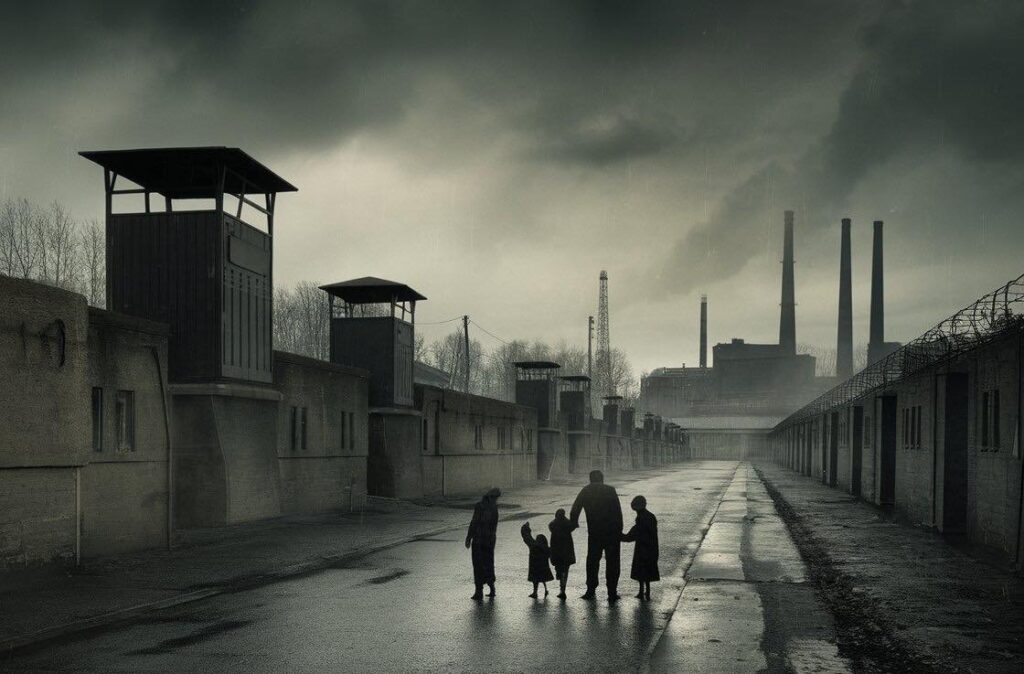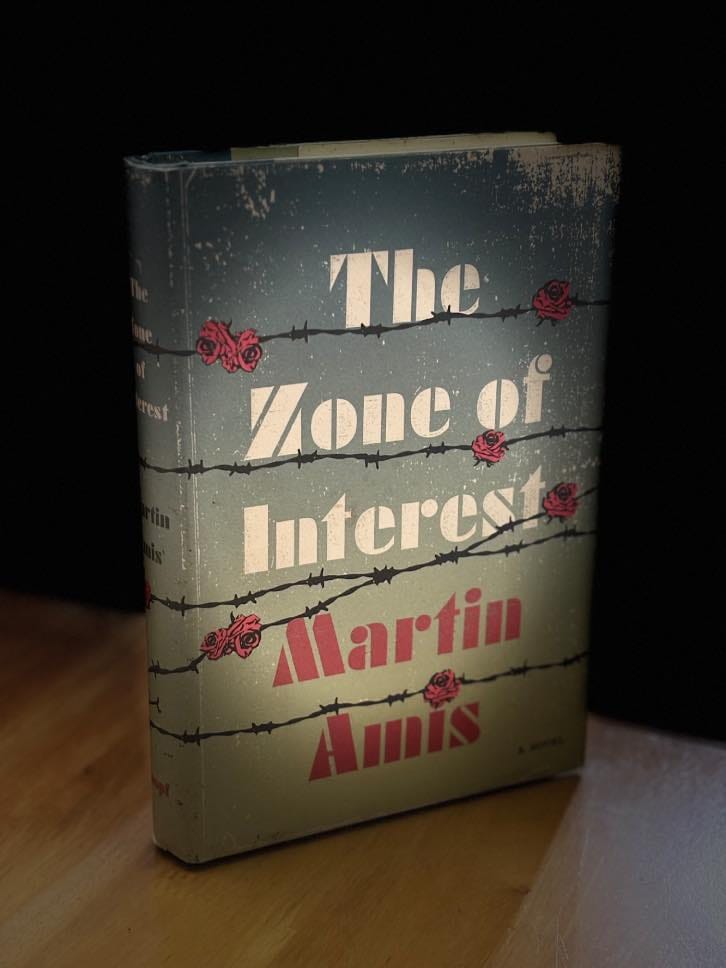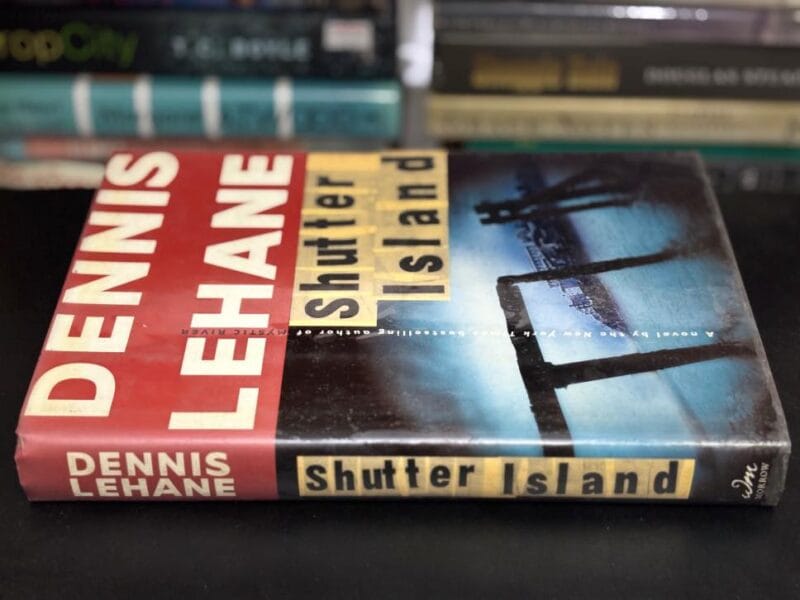Martin Amis’s The Zone of Interest (2014) is a book that demands deep rumination from its readers. Rather than offering a simple narrative, Amis crafts a multilayered piece of literature that explores the moral complexities of its characters, set against the chilling backdrop of Auschwitz.
While the historical setting is clear, Amis avoids a straightforward recounting of events, instead drawing readers into a world that is at once ordinary and horrifying, forcing us to confront difficult questions about humanity during one of history’s darkest periods.
The narrative delves into the paradox of normal family life unfolding amid the horrors of the Holocaust, highlighting the unsettling coexistence of domesticity and unspeakable evil. It explores how individuals strive to maintain a semblance of normalcy within a system built on unimaginable cruelty.
Thematic Focus

Amis does not present a world of clear-cut villains and heroes but rather characters who exist in shades of gray, each navigating the ethical paradoxes of their situation. When reading the book, we are constantly asked to grapple with questions of complicity and the limits of responsibility. The book’s portrayal of characters caught in the web of a larger, malevolent system forces us to confront the unsettling truth about systemic evil.
One of the book’s most striking techniques is the juxtaposition of the mundane and the atrocious. Amis presents scenes of ordinary life set against a backdrop of incomprehensible horror. This contrast is not only jarring but also profoundly disturbing, as it induces us to recognize how easy it is for cruelty and atrocity to become normalized within the course of daily life.
The effect is one of great discomfort, as we realize how thin the line between rationality and atrocity can be. The book portrays perpetrators of murder and systematic genocide as exhibiting an unsettling normalcy, highlighting the tension between evil actions and their perception of them as routine duties. This duality causes us to contemplate the moral dissonance between individual conscience and institutionalized cruelty inside the concentration camps.
Narrative Perspectives and Structure
Amis’s use of multiple narrators is one of the book’s defining features. Each voice offers a different lens through which we observe the unfolding events, and it’s through these varied perspectives that the reader is invited to engage with the book’s emotional core and moral dilemmas. The shifting viewpoints not only create a multilayered narrative but also challenge the reader to reconcile the paradoxes of each character’s perspective.
Shifting Voices
Amis constructs the narrative through three primary voices: Angelus Thomsen, Paul Doll, and Szmul Zacharias. The interplay of these voices emphasizes the starkly different experiences and the ethical challenges embedded in the book’s historical setting.
Thomsen, a Nazi officer, delivers a perspective shaped by his political alignment and personal ambitions. His complex relationship with the camp commandant’s wife blurs the lines between duty and desire, while exposing the psychological toll of maintaining power within a corrupt system. His growing disenchantment adds further nuance to his character, enhancing the reader’s understanding of his internal struggle.
Paul Doll, the commandant, offers chilling insights into the bureaucratic aspects of the camp’s operations. His narration underscores the commonplace nature of evil, emphasizing the routine execution of his administrative duties amidst the horrors unfolding just outside the walls of the Auschwitz concentration camp.
Szmul Zacharias is a Jewish Sonderkommando, a prisoner forced to assist the Nazis in their operations, particularly in the disposal of bodies. His narration contrasts the other voices by portraying the profound human suffering endured within the camps while revealing the harrowing reality of his forced complicity and brutal fight for survival.
Unreliable Narrators
The narrators are, in many ways, unreliable—not in the sense of outright deception but through their inability or unwillingness to fully confront the atrocities occurring around them. This unreliability plays a crucial role in shaping the reader’s experience, as it leads us to question what we are told and to consider what remains unsaid.
Amis skillfully incorporates the elements of unreliable narration through Doll and Thomsen. Doll’s self-serving justifications and opaque moral reasoning reveal the flaws and biases in his worldview. His denial and rationalizations serve to encapsulate the cognitive dissonance of perpetrators within the regime.
Thomsen’s narration, while more introspective, presents a flawed self-image and selective omissions. His attempts to distance himself from the brutality around him suggest a refusal to acknowledge complicity.
Fragmented Narrative and Pacing
Amis employs a fragmented narrative structure in The Zone of Interest, which mirrors the disorientation and psychological chaos of its subject matter. This structure disrupts the reader’s sense of continuity, reflecting the emotional and moral disarray of the characters. The nonlinear storytelling prompts readers to piece together the narrative, creating a sense of participation.
The pacing of the novel is deliberate, with shifts in narrative focus that heighten the emotional impact of certain scenes. Amis balances moments of quiet reflection with bursts of tension, creating a rhythm that keeps readers engaged even as the subject matter becomes increasingly disturbing. This pacing mirrors the emotional undercurrents of the novel, building suspense while also allowing space for introspection.
Literary Styles and Techniques
Tone and Atmosphere
The tension in The Zone of Interest builds slowly, simmering beneath the surface of seemingly uneventful moments. Amis’s use of sparse dialogue and detailed descriptions creates a creeping sense of dread, as if something terrible is always lurking just out of sight. The atmospheric tension sustains itself throughout the book, leaving the reader on edge, waiting for the inevitable but never quite prepared for it.
Amis’s prose is spare and clinical, a stylistic choice that creates an emotional distance between the reader and the characters. Characters are described with little sentiment, emphasizing actions and decisions over inner thoughts. This detached tone mirrors the emotional detachment of many of the book’s characters, who compartmentalize their actions and shield themselves from the moral implications of their duties.
The novel’s pacing and tonal shifts keep the reader alert, balancing the routine and the extraordinary in a finely tuned narrative tension. Through a dispassionate prose style with an underlying tension, the book examines themes of horror and ethics in a chillingly effective manner. For the reader, this style amplifies the novel’s cold and unsettling atmosphere.
Symbolism and Allegory
The title of the novel itself carries significant symbolic weight. On one level, it refers to a physical space, but on another, it operates as a metaphor for the psychological and moral boundaries the characters must navigate. The “zone of interest” can be interpreted as the area where human empathy is tested, where individuals must decide how far they are willing to go to justify their actions or inactions.
Amis’s novel also functions as an allegory for larger existential questions. The characters’ struggles with guilt, complicity, and self-preservation reflect broader human concerns about morality and responsibility in the face of systemic evil. The book pushes readers to consider their own zone of interest—the psychological spaces where moral choices are made, within the possibility of devastating consequences.
Duality of Characters
Amis’s characters are not simply embodiments of evil; they are deeply human, with flaws and contradictions that make them all the more troubling. He expertly portrays individuals who are both bureaucratic in their detachment and personal in their emotional struggles, creating a tension that resonates with readers. These are not straightforward villains, but people whose moral compass has been warped by the environment they inhabit.
The duality of the characters—simultaneously monstrous and recognizably human—complicates the reader’s sense of identification. We may feel repulsion at their actions, yet Amis’s nuanced portrayal forces us to see their humanity, making our emotional response far more complex. This psychological depth adds another layer of engagement, as we are compelled to reflect on the choices these characters make and the circumstances that shape them.
Through his stark and unsettling prose, Amis mirrors the fractured psyches of his characters, offering no redemption or even the distinctive delineation of clear-cut evil. Rather, he implicates us all in all its banality, in that creeping normalcy that permits horror to take root. Ultimately, the book leaves readers with a haunting question: how fragile is the boundary that separates us from the abyss? Amis, with chilling precision, suggests that this boundary is far more fragile than we are willing to admit.
Moral Complexity and the Human Condition
The Zone of Interest is a novel that lingers in the mind long after its final page, not only because of the grim subject matter but because of the profound questions it raises about human nature. Amis immerses the reader in a world where the mundane and the monstrous coexist, forcing an unsettling examination of how ordinary lives can adapt to unimaginable cruelty. The novel’s core lies in this disquieting juxtaposition, inviting reflection on the fragile boundaries of human empathy and responsibility.
Amis does not provide straightforward answers; instead, he probes beneath the surface, leaving the reader with a lingering sense of unease long after the final sentence. It is not merely the Holocaust—an all-too-familiar backdrop of human atrocity—but the intricate moral mechanisms he exposes that compel reflection. He coerces us to confront the compromises made, the subtle shifts in perception, and the unsettling ways that ordinary life can adapt to accommodate the unimaginable.
The novel’s layered narrative and shifting perspectives compel readers to engage with its complexities on a deeper level. Amis weaves together distinct voices, each exposing not only the individual moral struggles of the characters but also the broader implications of systemic evil. The result is a text that challenges the reader to question their own perceptions, creating a sense of complicity in the moral ambiguities that unfold.
The Zone of Interest achieves a remarkable balance between emotional depth and narrative restraint. Amis’s precise prose, combined with the intricacies of his storytelling, captures the weight of history without reducing it to a simple retelling. This nuanced approach allows the novel to stand as a powerful meditation on the darker aspects of human nature, leaving an indelible impact on contemporary fiction.
Selected Passage with Analysis
Have you noticed, at night, whilst drowsing, that when you reach down to readjust the sheet, you often find that this necessitates lifting yourself free of it? And what an enormous effort it seems to demand of you. Its a big thing, the body, a big, heavy thing, and this is a living body, mine—all right, soggy with sleep, but buoyant with life, life!
Page 116, The Zone of Interest by Martin Amis
This passage, found in the chapter "DOLL: Stucke," is narrated by Paul Doll, the camp commandant. This internal reflection, which dwells on the weight of his body and the effort of a simple movement, reveals Doll's self-absorbed nature and detachment from the atrocities around him. His fixation on the triviality of adjusting his sheet contrasts sharply with the grim reality of his surroundings, highlighting his emotional and moral numbness. This underscores a central theme of the novel, which is the dissonance between everyday banalities and the horrific cruelty of the Holocaust.
Amis employs literary devices like metaphor and synecdoche to deepen this reflection. The body represents the weight of living, with the act of adjusting the sheet symbolizing the broader struggle of life. The repeated use of "big" emphasizes the physical and existential burden, while the contrast between “soggy with sleep” and “buoyant with life” creates a tension between weariness and vitality. This juxtaposition highlights the paradox of being alive: the body is simultaneously a source of life and a heavy, inescapable presence.
Further Reading
The Hilarity of Evil by Morten Høi Jensen, Los Angeles Review of Books
The Holocaust Novel—And Movie—That Defy All Expectations by Katey Rich, Vanity Fair
Review: Martin Amis takes on Nazi love in ‘Zone of Interest.’ Really. by Lydia Millet, Los Angeles Times
The Zone of Interest was Martin Amis’s greatest novel of the 21st century by John Self, The Independent




